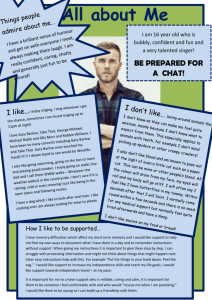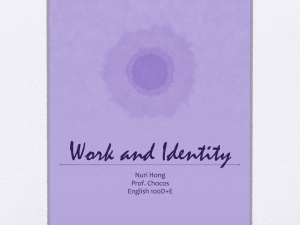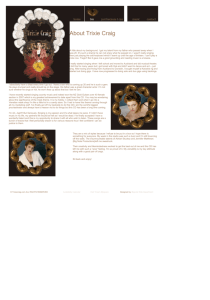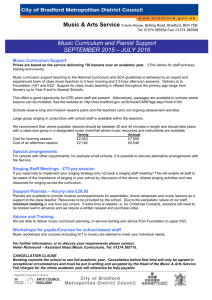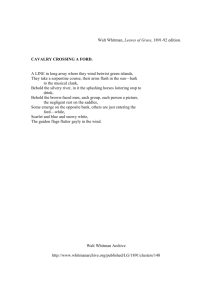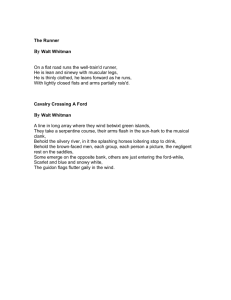11-18-15 I Hear America Singing (1867).
advertisement
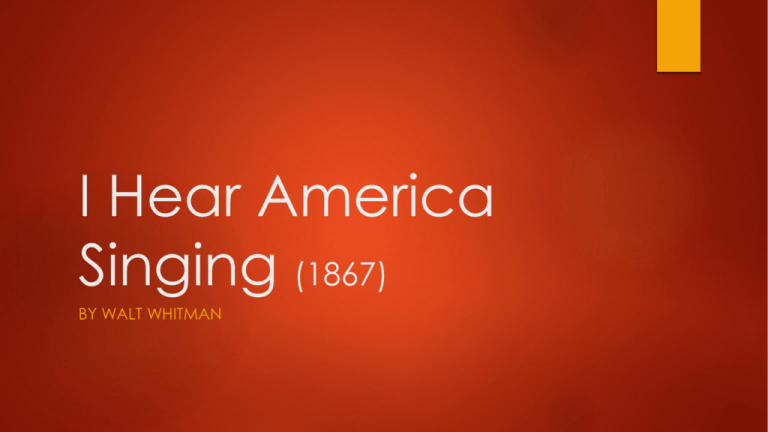
I Hear America Singing (1867) BY WALT WHITMAN I Hear America Singing by Walt Whitman I HEAR America singing, the varied carols I hear; Those of mechanics – each singing his, as it should be, blithe and strong; blithe – carefree, happy I Hear America Singing by Walt Whitman The carpenter singing his, as he measures his plank or beam, plank – board or slat I Hear America Singing by Walt Whitman The mason singing his, as he makes ready for work, or leaves off work; I Hear America Singing by Walt Whitman The boatman singing what belongs to him in his boat – the deckhand singing on the steamboat deck; I Hear America Singing by Walt Whitman The shoemaker singing as he sits on his bench – the hatter singing as he stands; I Hear America Singing by Walt Whitman The wood-cutter’s song – the ploughboy’s, on his way in the morning, or at the noon intermission, or at sundown; ploughboy – or plowboy; a person who guides animals with a plough I Hear America Singing by Walt Whitman The delicious singing of the mother – or of the young wife at work – or the girl sewing or washing – Each singing what belongs to her, and to none else; I Hear America Singing by Walt Whitman The day what belongs to the day – At night, the party of young fellows, robust, friendly, I Hear America Singing by Walt Whitman Singing, with open mouths, their strong melodious songs. Purpose What is the purpose of this poem? Honoring the pride and spirit of what makes our country special To reveal the real backbone of America in the common workers To embrace the true voice of America through the common worker Theme a general idea expressed by a literary work. There can be more than one theme in a work. Example—The theme of “The Tortoise and the Hare” is that slow, steady effort triumphs over natural but undeveloped talent. What are the themes in “I Hear America Singing”? Work Visions of America Art and Culture: Music Tone The feeling an author conveys to the reader. Tone contributes to the overall mood of a work. Example—Tone can be formal, serious, passionate, lighthearted, witty, sarcastic, or any other general expression of feeling. What is the tone of this poem? What words convey this tone? Brotherly, admiring, grateful Robust, friendly, strong, blithe, belong, melodious, singing Cataloguing Creating long lists for poetic or rhetorical effect. The technique is common in epic literature, where conventionally the poet would devise long lists of famous princes, aristocrats, warriors, and mythic heroes to be lined up in battle and slaughtered. The technique is also common in the practice of giving illustrious genealogies ("and so-and-so begat so-and-so," or "x, son of y, son of z" etc.) for famous individuals. An example in American literature is Whitman's multi-page catalog of American types in section 15 of "Song of Myself." An excerpt appears below: The pure contralto sings in the organ loft, The carpenter dresses his plank, the tongue of his foreplane whistles its wild ascending lisp, The married and unmarried children ride home to their Thanksgiving dinner, The pilot seizes the king-pin, he heaves down with a strong arm, The mate stands braced in the whale-boat, lance and harpoon are ready, The duck-shooter walks by silent and cautious stretches, The deacons are ordained with crossed hands at the altar, The spinning-girl retreats and advances to the hum of the big wheel, The farmer stops by the bars as he walks on a First-day loaf and looks at the oats and rye, The lunatic is carried at last to the asylum a confirmed case.... [etc.] What exactly is it that Whitman catalogues in his poem “I Hear America Singing”? Parallelism Parallelism is the use of components in a sentence that are grammatically the same; or similar in their construction, sound, meaning, or meter. This method adds balance and rhythm to sentences, giving the ideas a smoother flow. Parallelism can be persuasive because of this balance, smoothness, and flow. For example: “Whenever you need me, wherever you need me, I will be there for you.” Another example: “Alice ran into the room, into the garden, and into our hearts.” Whitman uses parallelism to set up his cataloguing. What is the parallel structure of the poem? How does this add to the sound of the poem? Worker + singing + description of what/where/how he/she is singing Adds rhythm Free Verse Poetry that does not rhyme or have a regular meter (tempo, pattern, beat, rhythm). Why do you think Whitman chose free verse for this poem? The ease of the form fits the laid back nature of his subjects – the working man. It reflects the way common people talk more so than the strict structures of romantic poetry.
